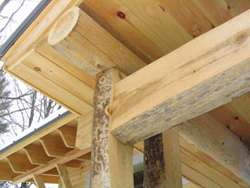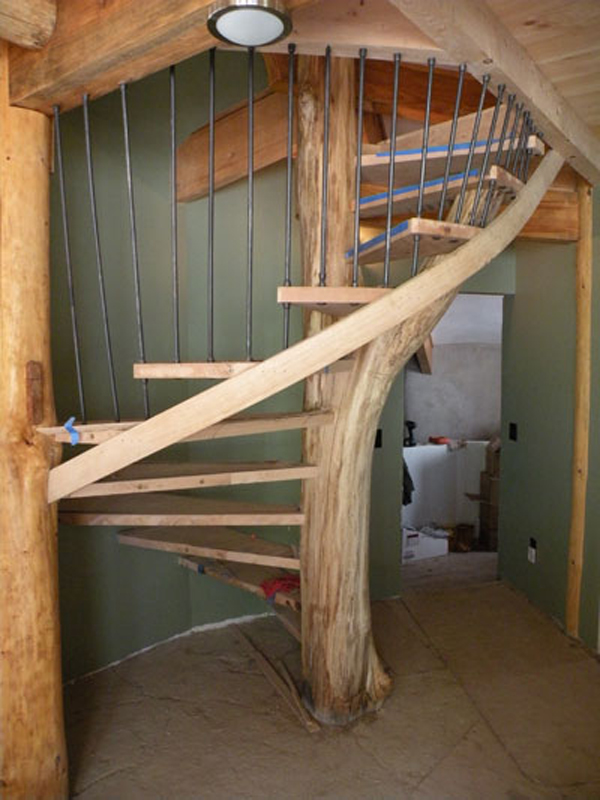
“Round Timberframing. Harvesting trees from the site where we are building and using the trees as round structural members is ideal. Certainly this is time and labor intensive, although structurally, round timbers outperform milled timbers of the same dimension. This is because of the natural spiral form of the tree grain which is lost when the tree is milled. This spiral form is what allows tree branches of large girth to hang horizontally to limits that seem unbelievable.
Timberframing has been around for thousands of years. When properly designed, a timberframe can use a modest amount of lumber while achieving a lengthy life of several hundred years. In the Northeast, timberframing is a natural choice for our bioregion.

Building in the Round. The spiral staircase is a wonderful example of building in the round. It shows how incorporting not only round forms but round movement, or spiral movement can create a dynamic element of a home or space. The concept of building in the round has spiritual underpinnings. It is also grounded in craft and respect for materials and how they are harvested.
Stone is well used when it is found on the building site. This is a time honored building material that connects us to the beginings of our culture. A durable and possibly the longest lasting building material. Stone can ground a structure both physically and visually. One of the reasons that buildings no longer look rooted to the ground is because they have lost their stone foundations. Stone can be used in many places in a structure.”
Read more at the source: Natural Design Build.us
Click to see their portfolio

Naaahhh…..I’m installing an elevator hahahaha
Well, Carroll, with the 7 story house referenced the other day to hold all those dozens of kids you have, you’ll have plenty of opportunity to install a large variety of different staircases. Your kids should be able to bump their butts, roll their toys, and stay in great physical shape after climbing 7 stories of stairs day after day.
/snicker
That should keep them busy.
Excellent points Jay.
Jokes about staircases aside…
Sometimes it’s worthwhile to re-state the obvious that most reading this blog are already aware of.
I’m a fan of round timberframing. Of course, this type of construction requires a supply of round timbers. While these are available in many wooded regions, there are plenty of places where trees are endagered, scarce, or even non-existent. In those regions, it’s wise to explore other options.
Sustainably harvesting timber is not easy. It’s a very useful resource when managed appropriately, but when not, the resulting devastation can be stark.
I recommend each prospective builder consult with a foresting expert in his/her own area to determine how much timber can be harvested from your own land without damaging the ability for your particular eco-system to re-grow. Like most everything in nature, it requires a balanced approach. Upset that balance too much, and the ripple effects can severely damage and sometimes even destroy the very reason you wanted to build your house on your chosen land first place. Each region is different. That’s why it’s wise to consult with a local expert. A couple hours of consulting time is very cheap for the amount of knowledge and understanding that can be gained.
The best approach is to start your initial house design process by looking at your land carefully and deciding what building materials are already abundant at the site. Choose a design that maximizes those materials while minimizing the use of materials that are less abundant at your site.
This is a simple concept, but oftentimes can be difficult to put into practice. However, with patience, education of oneself, careful observation, and hard work, the solutions always seem to be there. One simply needs to be open to them.
It is possible to work in the other direction, but expect your options to be more limited, and often more expensive. If your heart is set on one particular house design or style, then it becomes important to choose land and a building site where the materials of the design you want are already available.
If someone is determined to build a round timberframe/strawbale structure, it would be wise to choose wooded land where there are wheat/rice/barley fields close by. If there is volcanic rock nearby to use for foundation insulation, all the better.
Sometimes it can be useful to remind ourselves of obvious concepts such as these, because it is often too easy to be so distracted by the details that we lose site of the big picture.
As I said, I’m a big fan of round timberframing. Just be smart about what you cut and where you cut it.
There are so many options, so many different ways of building that it can get confusing. No one building system is perfect for every situation. Take time to learn what’s best for you.
Jay
You really did say something in your round about funny way about stimulation. To me, todays standard homes and particularly apartments I compare to small little “cells” There certainly isn’t much stimulation there at all and if anything, could help in the development of depression in a person. Do you follow where I’m coming from? A home should be a place where you really “feel” glad to be there. A place where you can leave that outside the door. A home should be a “fun house” for the spirit. As for kids, they should be considered when building a home foremost because their heads swirl a lot faster than an adults so, stimulation is not only in the build but, what the parents do to stimulate their minds. The combination of the two and you’ll have pretty smart and well behaved children who grow up to make you proud I believe. Er….that’s with or without a slinky but, the parents could probably use that though…..
I don’t know of any studies that indicate children’s intelligence is increased by living in curved/round structures but it wouldn’t surprise me in the least. Are there any educator’s reading this who have access to educational databases? Please do a thesis/title search on this if you have time.
Each different design element has its own advantages and disadvantages.
Straight stairs, for example are great fun when you are 4 years old and you sit on a pillow to slide down the stairs for a bumpy ride. With spiral stairs, you just bump into the railing when attempting this.
On the other hand, spiral staircases are great fun to roll beachballs down. Way more fun than straight staircases for this activity.
Standard “code built” carpeted stairs are the least fun of all.
It’s a difficult choice. The style of stair you choose ultimately says a lot about you and the cognitive development of your kids.
I propose that the reason our children’s test scores are falling is because most children are living in a home that is boring and does not stimulate their mental abilities. After all, nothing stimulates the brain like a bumpy ride on a pillow sliding down a staircase!
Well, okay, maybe the bumpy ride is not particularly mentally stimulating, but …
THINK OF THE SLINKY!!
A home that doesn’t have a quality slinky run isn’t a house worth raising a child in!
We’re planning a spiral staircase on the Wiki Natural House. The design is coming along nicely.
Very nice builds. What is so great about Alternative Building is the fact that you can include so many ideas from different methods into your builds. These stairs are one of my favorites.
Yeah, the possibilities are endless.